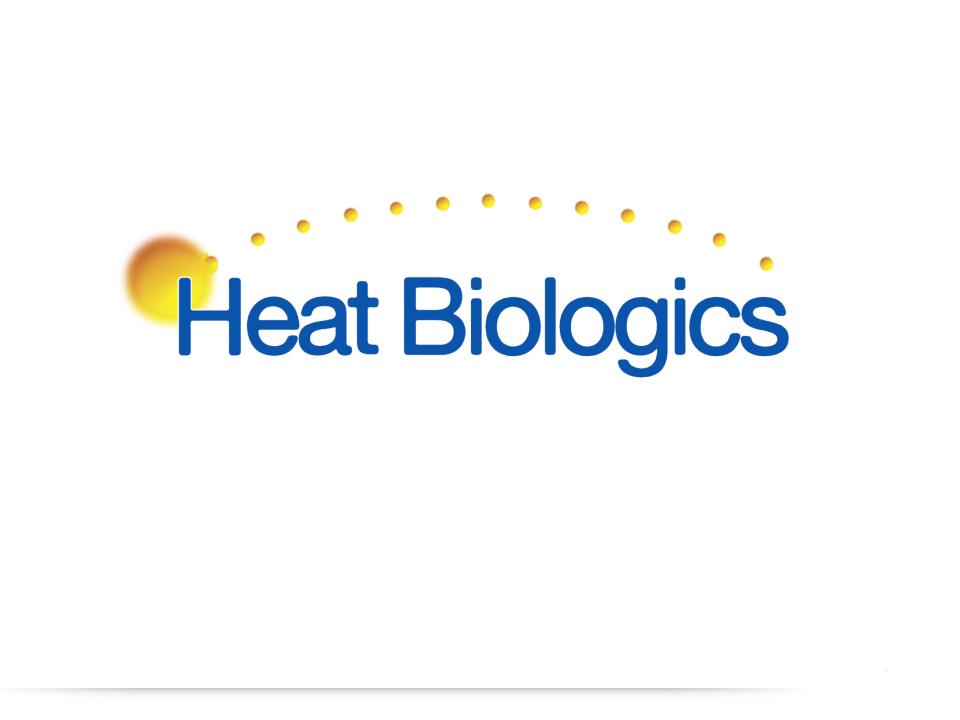FWP: Filing under Securities Act Rules 163/433 of free writing prospectuses
Published on July 8, 2013
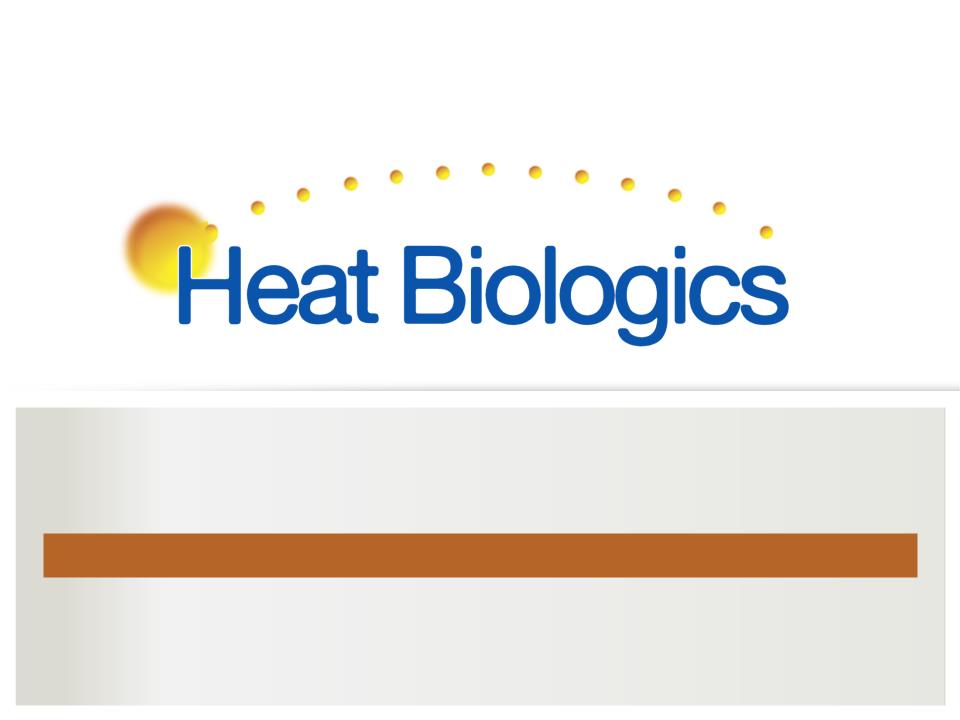
Corporate Presentation
July 2013
Issuer Free Writing Prospectus
Filed pursuant to Rule 433
Registration No. 333-188365
July 8, 2013
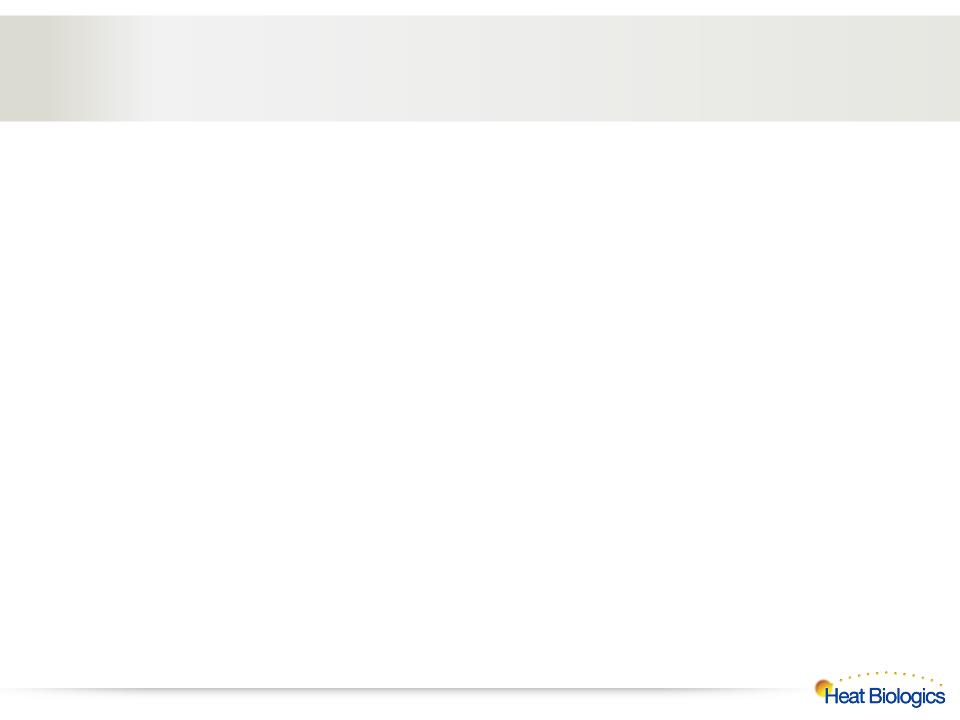
2
Forward Looking Statements
This presentation includes statements that are, or may be deemed, ‘‘forward-looking statements.’’ In some cases, these forward-looking
statements can be identified by the use of forward-looking terminology, including the terms “believes,” “estimates,” “anticipates,” “expects,”
“plans,” “intends,” “may,” “could,” “might,” “will,” “should,” “approximately” or, in each case, their negative or other variations thereon or
comparable terminology, although not all forward-looking statements contain these words. They appear in a number of places throughout this
presentation and include statements regarding our intentions, beliefs, projections, outlook, analyses or current expectations concerning, among
other things, our ongoing and planned discovery and development of drugs targeting cancer stem cells, the strength and breadth of our intellectual
property, our ongoing and planned preclinical studies and clinical trials, the timing of and our ability to make regulatory filings and obtain and
maintain regulatory approvals for our product candidates, the degree of clinical utility of our products, particularly in specific patient populations,
expectations regarding clinical trial data, our results of operations, financial condition, liquidity, prospects, growth and strategies, the length of
time that we will be able to continue to fund our operating expenses and capital expenditures, our expected financing needs and sources of
financing, the industry in which we operate and the trends that may affect the industry or us.
statements can be identified by the use of forward-looking terminology, including the terms “believes,” “estimates,” “anticipates,” “expects,”
“plans,” “intends,” “may,” “could,” “might,” “will,” “should,” “approximately” or, in each case, their negative or other variations thereon or
comparable terminology, although not all forward-looking statements contain these words. They appear in a number of places throughout this
presentation and include statements regarding our intentions, beliefs, projections, outlook, analyses or current expectations concerning, among
other things, our ongoing and planned discovery and development of drugs targeting cancer stem cells, the strength and breadth of our intellectual
property, our ongoing and planned preclinical studies and clinical trials, the timing of and our ability to make regulatory filings and obtain and
maintain regulatory approvals for our product candidates, the degree of clinical utility of our products, particularly in specific patient populations,
expectations regarding clinical trial data, our results of operations, financial condition, liquidity, prospects, growth and strategies, the length of
time that we will be able to continue to fund our operating expenses and capital expenditures, our expected financing needs and sources of
financing, the industry in which we operate and the trends that may affect the industry or us.
By their nature, forward-looking statements involve risks and uncertainties because they relate to events, competitive dynamics, and healthcare,
regulatory and scientific developments and depend on the economic circumstances that may or may not occur in the future or may occur on longer
or shorter timelines than anticipated. Although we believe that we have a reasonable basis for each forward-looking statement contained in this
presentation, we caution you that forward-looking statements are not guarantees of future performance and that our actual results of operations,
financial condition and liquidity, and the development of the industry in which we operate may differ materially from the forward-looking
statements contained in this presentation as a result of, among other factors, the factors referenced in the “Risk Factors” section of our
Registration Statement on Form S-1 initially filed with the Securities and Exchange Commission on May 6, 2013 as subsequently amended to date
(our “Registration Statement”). In addition, even if our results of operations, financial condition and liquidity, and the development of the industry
in which we operate are consistent with the forward-looking statements contained in this presentation, they may not be predictive of results or
developments in future periods. Any forward-looking statements that we make in this presentation speak only as of the date of such statement,
and we undertake no obligation to update such statements to reflect events or circumstances after the date of this presentation, except as
required by law.
regulatory and scientific developments and depend on the economic circumstances that may or may not occur in the future or may occur on longer
or shorter timelines than anticipated. Although we believe that we have a reasonable basis for each forward-looking statement contained in this
presentation, we caution you that forward-looking statements are not guarantees of future performance and that our actual results of operations,
financial condition and liquidity, and the development of the industry in which we operate may differ materially from the forward-looking
statements contained in this presentation as a result of, among other factors, the factors referenced in the “Risk Factors” section of our
Registration Statement on Form S-1 initially filed with the Securities and Exchange Commission on May 6, 2013 as subsequently amended to date
(our “Registration Statement”). In addition, even if our results of operations, financial condition and liquidity, and the development of the industry
in which we operate are consistent with the forward-looking statements contained in this presentation, they may not be predictive of results or
developments in future periods. Any forward-looking statements that we make in this presentation speak only as of the date of such statement,
and we undertake no obligation to update such statements to reflect events or circumstances after the date of this presentation, except as
required by law.
You should read carefully our “Special Cautionary Notice Regarding Forward-Looking Statements” and the factors described in the “Risk Factors”
sections of our Registration Statement to better understand the risks and uncertainties inherent in our business.
sections of our Registration Statement to better understand the risks and uncertainties inherent in our business.
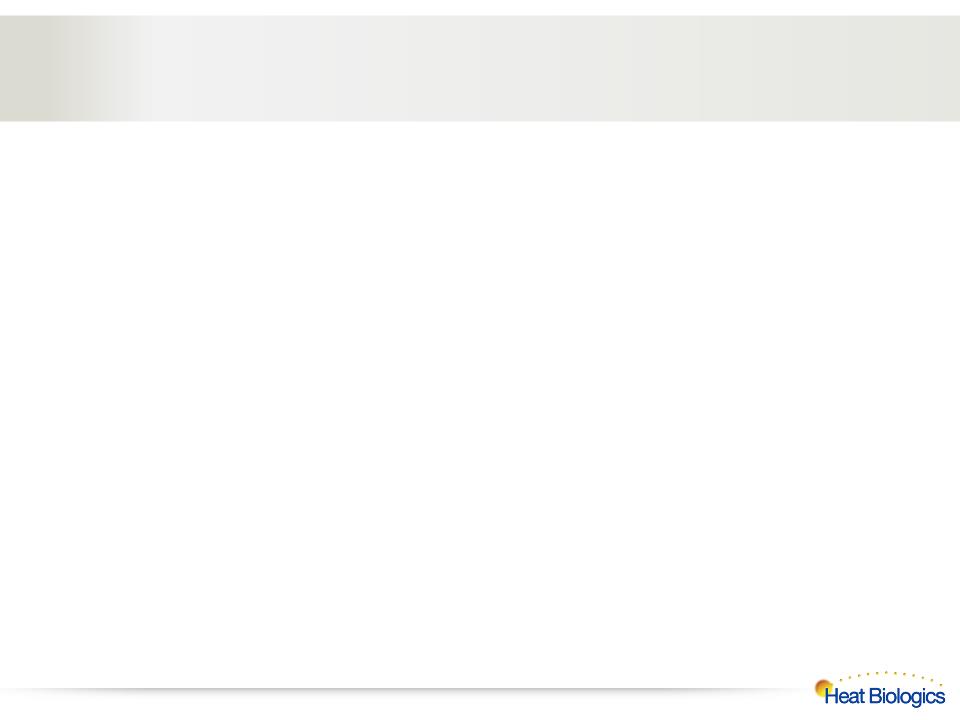
3
Free Writing Prospectus Statement
This presentation highlights basic information about us and the offering. Because it is a summary, it does not contain all of the information that you
should consider before investing.
should consider before investing.
We have filed a registration statement (including a preliminary prospectus) with the SEC for the offering to which this presentation relates. The
registration statement has not yet become effective. Before you invest, you should read the preliminary prospectus in the registration statement
(including the risk factors described therein) and other documents we have filed with the SEC for more complete information about us and the
offering.
registration statement has not yet become effective. Before you invest, you should read the preliminary prospectus in the registration statement
(including the risk factors described therein) and other documents we have filed with the SEC for more complete information about us and the
offering.
You may get these documents for free by visiting EDGAR on the SEC Web site at http://www.sec.gov. The preliminary prospectus, dated July 8,
2013, is available on the SEC Web site at http://www.sec.gov. Alternatively, we or any underwriter participating in the offering will arrange to send
you the prospectus if you contact Aegis Capital Corp., Prospectus Department, 810 Seventh Avenue, 18th Floor, New York, NY 10019, telephone: 212-
813-1010, e-mail: prospectus@aegiscap.com
2013, is available on the SEC Web site at http://www.sec.gov. Alternatively, we or any underwriter participating in the offering will arrange to send
you the prospectus if you contact Aegis Capital Corp., Prospectus Department, 810 Seventh Avenue, 18th Floor, New York, NY 10019, telephone: 212-
813-1010, e-mail: prospectus@aegiscap.com
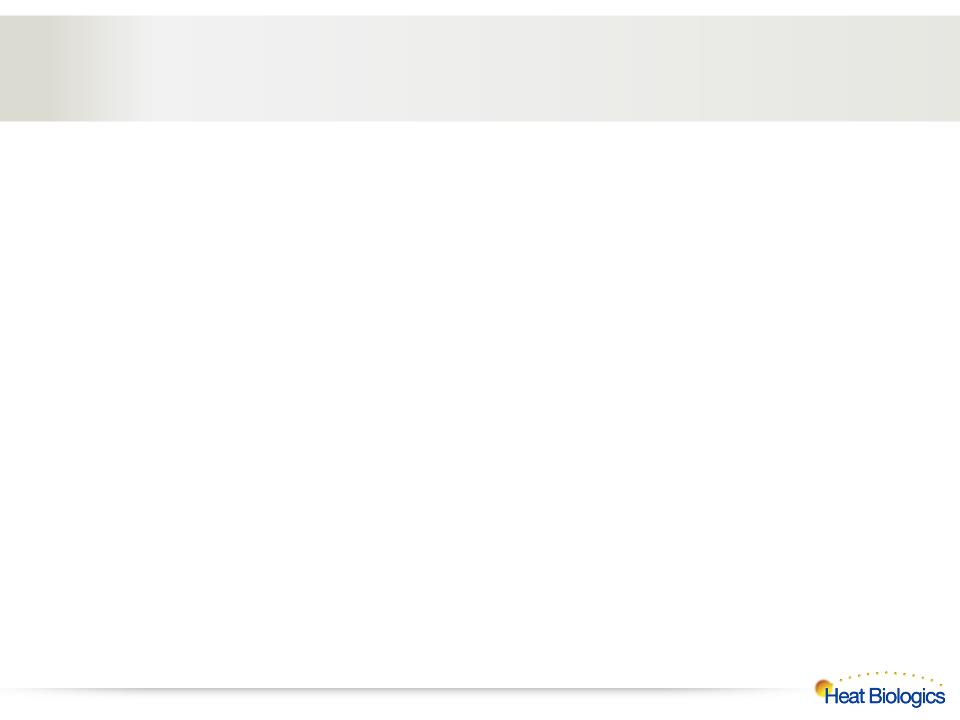
4
Offering Summary
Deal Terms
|
SHARES OFFERED
|
2,272,727 (100% Primary)
|
|
PRICE RANGE
|
$10.00 - $12.00 per Share
|
|
EXCHANGE / TICKER
|
NASDAQ Capital Market / HTBX
|
|
OVER-ALLOTMENT
|
15% or 340,909 (100% Primary)
|
|
USE OF PROCEEDS
|
Clinical Development of HS-110 and HS-410 and
Other General Corporate Purposes |
|
SOLE BOOK-RUNNER
|
Aegis Capital Corp
|
|
CO-MANAGER
|
Cantor Fitzgerald & Co.
|
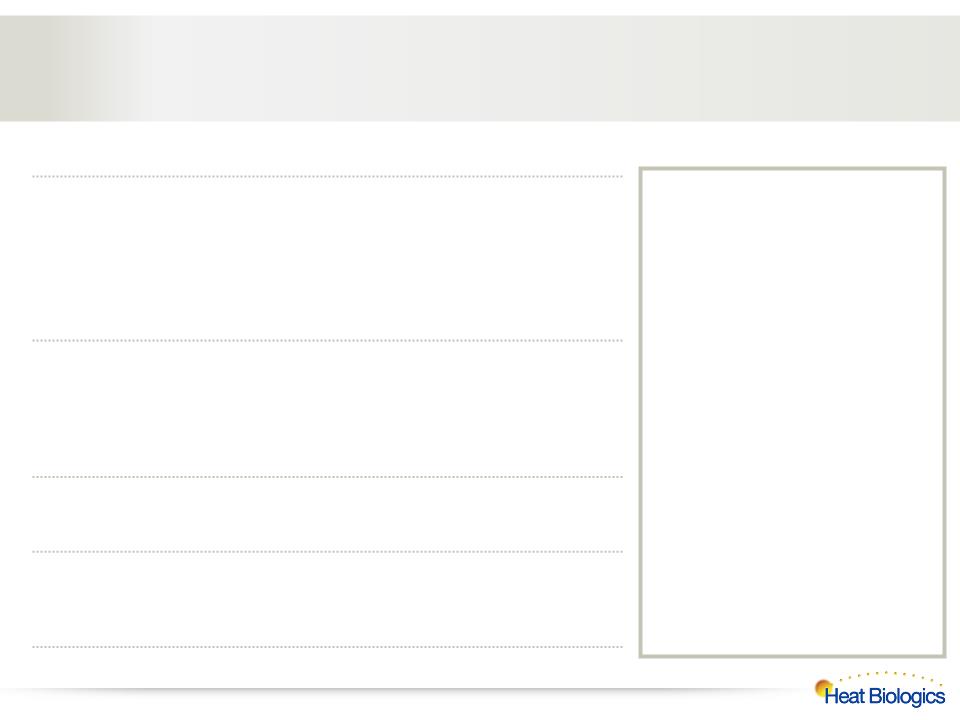
5
The Heat Biologics Team
|
Jeffrey Wolf
Founder, Chairman and CEO
|
• Founded Heat Biologics and advanced company
to current clinical stage
• Founder/CEO of several biotech companies including
Elusys Therapeutics (founder/Chairman/CEO), TyRx Pharma (co-founder/Chairman), Avigen (NASDAQ: AVGN) (co-founder/director)
• BA, University of Chicago; JD, New York University School
of Law; MBA, Stanford Business School |
|
Sandra Silberman, MD, Ph.D
Chief Medical Officer
|
• Oversaw the clinical development of Tarceva™ at Pfizer
• Led global development and FDA approval of
of Gleevec™ at Novartis. Senior oncology clinical development positions Eisai and Quintiles
• MD, Cornell University Medical College; Ph.D. in Tumor
Immunology, Johns Hopkins University |
|
Matt Czajkowski
Chief Financial Officer
|
• Chief Financial Officer at Pozen Inc. (NASDAQ: POZN)
• BA, Harvard College; MBA, Harvard Business School
|
|
Jennifer Harris, Pharm. D.
VP of Clinical and Regulatory
Affairs |
• Significant experience in the clinical development of
cancer immunotherapies with Dendreon, Celgene and Novaquest (Quintiles)
• BS and Pharm.D, University of North Carolina, Chapel Hill
|
Scientific Advisory Board
Eckhard Podack, MD, Ph.D.
Chairman of Scientific Advisory Board
Chairman of Microbiology and Immunology,
University of Miami
University of Miami
James Allison, Ph.D.
Former Chairman of Immunology Program,
Memorial Sloan Kettering
Memorial Sloan Kettering
Sol Barer, Ph.D.
Co-founder, former Chairman and CEO, Celgene
John Nemunaitis, MD
Executive Medical Director,
Mary Crowley Cancer Research Center
Mary Crowley Cancer Research Center
Justin Stebbing, MD, Ph.D.
Imperial College, London
Daniel Von Hoff, MD
Translational Genomics Research Institute
Past President of American Association of
Cancer Research
Cancer Research
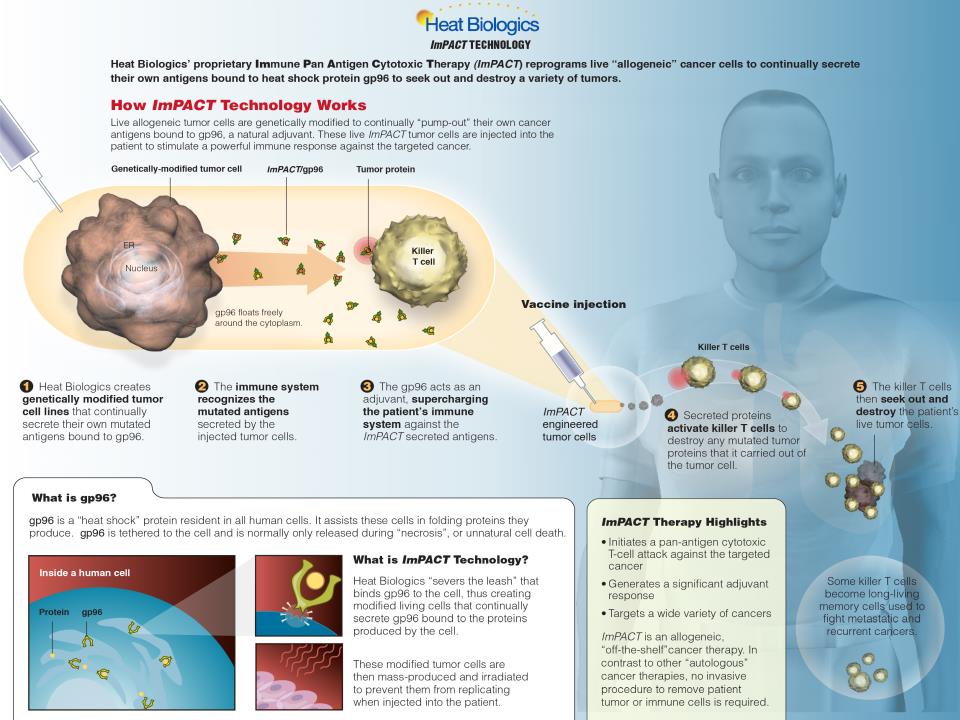
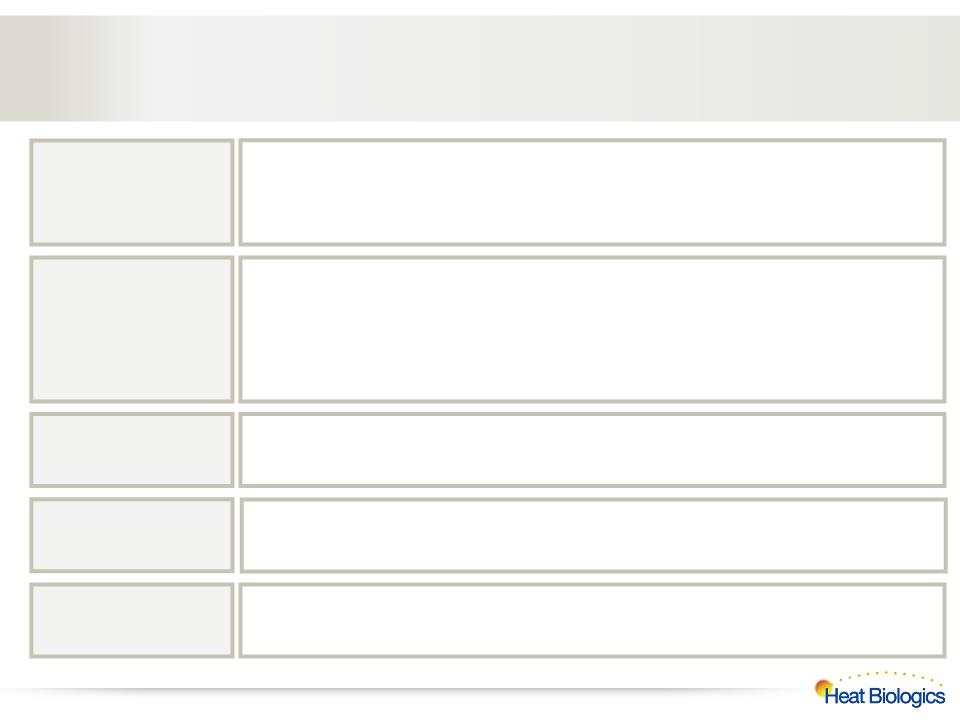
7
Heat Biologics Highlights
l Transformative immunotherapy platform that unleashes a robust pan-antigen T-cell attack against a
wide range of cancers
wide range of cancers
l Fully-allogeneic, “off-the-shelf” drugs with COGS < 5% of autologous cancer vaccine approaches
l Multiple near-term registration opportunities (>$60 Billion TAM)
Broad-based
Immunotherapy
Platform
l 18-patient Phase 1 investigator-sponsored IND in advanced non-small cell lung cancer
– Positive safety data with no treatment-related SAEs
– Powerful disease-specific immune activation
– Preliminary evidence that immune activation corresponds with increased overall survival
l Median 1-year overall survival rate in advanced NSCLC of 43% compared favorably to a 5.5% rate
based on published data from a 43-patient advanced NSCLC population
based on published data from a 43-patient advanced NSCLC population
l One patient survives >3 yrs. and another patient survives >4 yrs. since starting therapy
Promising
Clinical Data
l IPO net proceeds will be used to progress two drug candidates through Phase 2 clinical trials
– HS-110 for non-small cell lung cancer (NSCLC)
– HS-410 for bladder cancer
Diverse
Clinical Pipeline
l IPO net proceeds expected to progress two clinical programs through Phase 2 trials
l Multiple value-creating milestones planned over the next 12-24 months
Milestones
l Strong management and scientific team includes SAB members Sol Barer (Celgene), James Allison
(Sloan Kettering), Eckhard Podack (Miami), Daniel Von Hoff (TGen)
(Sloan Kettering), Eckhard Podack (Miami), Daniel Von Hoff (TGen)
Experienced
Team
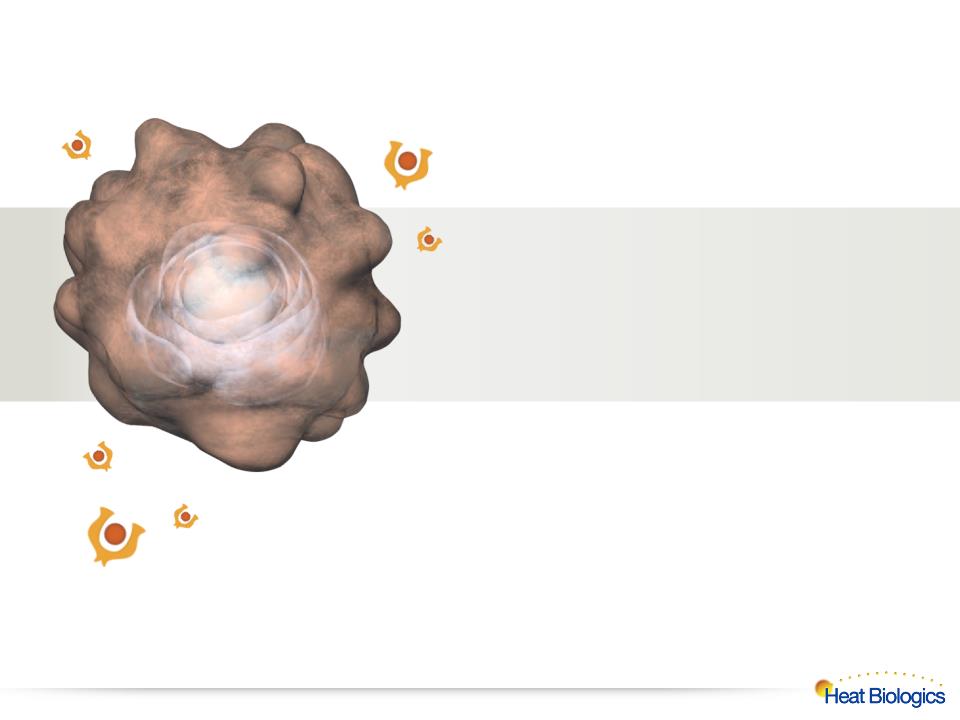
8
Heat’s ImPACT Therapy
Living Drug Factories
Antigen and adjuvant delivery in a single package
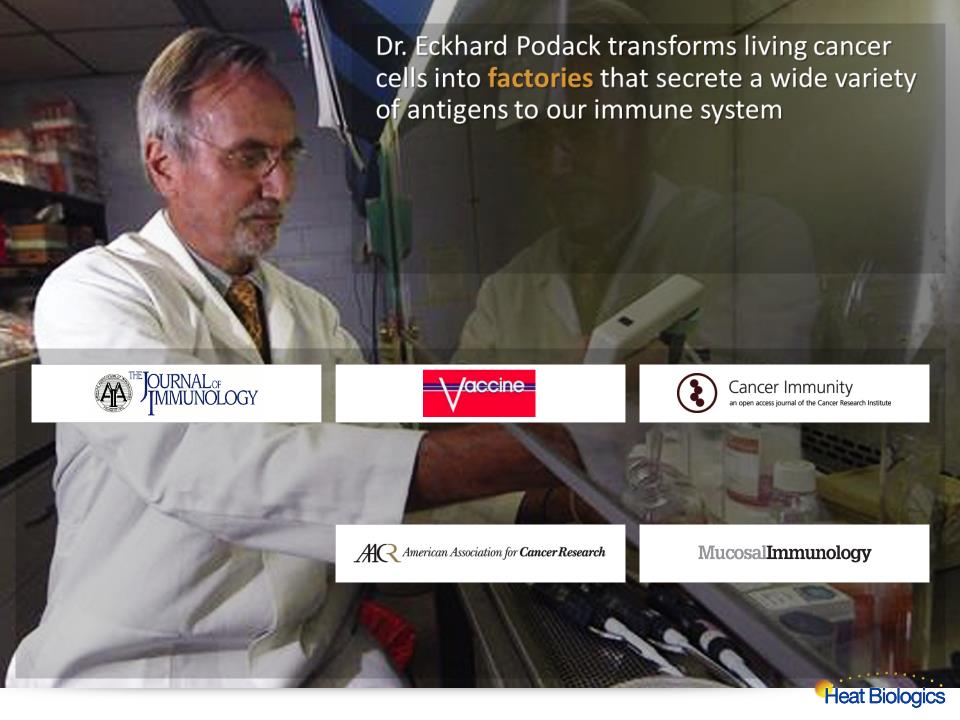
9
• Chairman, Dept. of Immunology University of Miami
• Discover of Perforin
• Inventor of Seattle Genetics CD30 antibody (Adcetris®)
recently approved by FDA for Hodgkin Lymphoma
recently approved by FDA for Hodgkin Lymphoma
• Inventor of Heat’s ImPACT Technology
Cutting Edge: Tumor Secreted Heat Shock-Fusion
Protein Elicits CD8 Cells for Rejection.
Protein Elicits CD8 Cells for Rejection.
K. Yamazaki, T. Nguyen, E.R. Podack.
Molecular and Cellular Requirements for Enhanced
Antigen Cross-Presentation to CD8 Cytotoxic T
Lymphocytes.
Antigen Cross-Presentation to CD8 Cytotoxic T
Lymphocytes.
S. Oizumi, N. Strbo, S. Pahwa, V. Deyev,
E.R. Podack.
E.R. Podack.
Surmounting tumor-induced immune suppression
by frequent vaccination or immunization in the
absence of B cells.
by frequent vaccination or immunization in the
absence of B cells.
S. Oizumi, V. Deyev, K. Yamazaki,, T. Schreiber,
N. Strbo, J. Rosenblatt, E.R. Podack.
N. Strbo, J. Rosenblatt, E.R. Podack.
Cell surface expression of heat shock protein
gp96 enhances cross-presentation of cellular
antigens and the generation of tumor-specific T-
cell memory.
gp96 enhances cross-presentation of cellular
antigens and the generation of tumor-specific T-
cell memory.
J. Dai, B. Liu, M.M. Caudill, H. Zheng, Y. Qiao, E.R.
Podack, Z. Li.
Podack, Z. Li.
Cell-secreted gp96-Ig-peptide complexes induce
lamina propria and intraepithelial CD8+
cytotoxic T lymphocytes in the intestinal
mucosa.
lamina propria and intraepithelial CD8+
cytotoxic T lymphocytes in the intestinal
mucosa.
N. Strbo, S. Pahwa, M.A. Kolber, L. Gonzalez, E.
Fisher, E.R. Podack.
Fisher, E.R. Podack.
Gp96SIV Ig immunization induces potent
polyepitope specific, multifunctional memory
responses in rectal and vaginal mucosa.
polyepitope specific, multifunctional memory
responses in rectal and vaginal mucosa.
N. Strboa, M. Vaccaric, S. Pahwaa, M.A.
Kolberb, E. Fishera, L. Gonzaleza, M.N.
Dosterc, A. Hryniewiczc, B.K. Felbere, G.N.
Pavlakisf, G. Franchinic, E.R. Podack.
Kolberb, E. Fishera, L. Gonzaleza, M.N.
Dosterc, A. Hryniewiczc, B.K. Felbere, G.N.
Pavlakisf, G. Franchinic, E.R. Podack.
Tumor-induced suppression of CTL expansion
and subjugation by gp96-Ig vaccination.
and subjugation by gp96-Ig vaccination.
T.H. Schreiber, V. Deyev, J.D. Rosenblatt , E.R.
Podack.
Podack.

10
Introducing gp96 — Immune System’s “Swiss Army
Knife”*
Knife”*
“Molecular Warning System”
* Schild, H. & Rammensee, H. Gp-96 - The Immune System’s Swiss Army Knife. Nature Immunology 2, 100
-101 (2000)
-101 (2000)
gp96
antigen
leash
l “Chaperone” protein expressed in all our cells and
variety of tumors
variety of tumors
l Activates a pan-antigen T-cell response by enabling
MHC I antigen cross-presentation to CD8+ T-cells
MHC I antigen cross-presentation to CD8+ T-cells
l Gp96 + client protein naturally released via necrosis
l Among the most powerful adjuvants and the only
adjuvant to show exclusive specificity to CD8+ T-cells
adjuvant to show exclusive specificity to CD8+ T-cells
– Provides non-specific signals to the innate immune
system and specific signals to adaptive immune system
system and specific signals to adaptive immune system
Tethered to our cells with a leash

11
ImPACT Therapy — “Severing the Leash”
Heat Biologics ImPACT technology removes the leash that binds
gp96 to the cell, creating cells that continually secrete gp96
gp96 to the cell, creating cells that continually secrete gp96
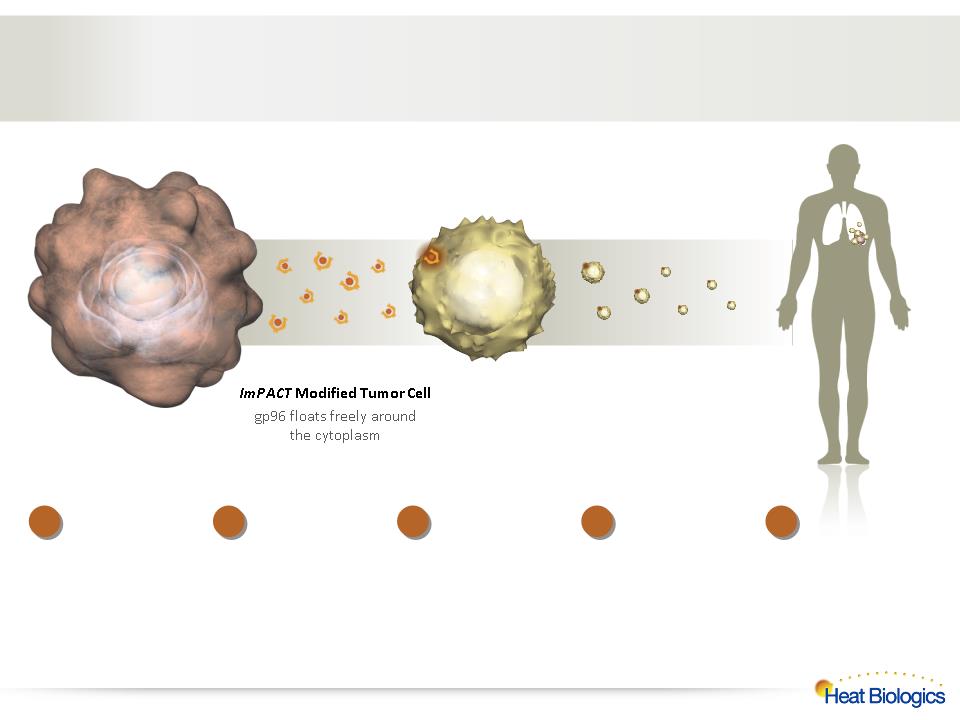
12
Vaccine Injection
Inject living ImPACT cells
into the patient
into the patient
ImPACT Therapy — Process
Non-functional
Tumor Cell
Tumor Cell
Killer
T-Cell
T-Cell
Heat Biologics
creates genetically
modified tumor cell
lines to continually
secrete their own
mutated antigens
bound to gp96.
creates genetically
modified tumor cell
lines to continually
secrete their own
mutated antigens
bound to gp96.
2
Scale-up production of
these living tumor cells
as our “drug” to treat
all patients with a
particular cancer.
Irradiate these cells so
they can’t replicate and
vial for distribution.
these living tumor cells
as our “drug” to treat
all patients with a
particular cancer.
Irradiate these cells so
they can’t replicate and
vial for distribution.
3
Inject these living,
genetically-modified
cells into patients.
These cells
continuously secrete
tumor proteins bound
to gp96.
genetically-modified
cells into patients.
These cells
continuously secrete
tumor proteins bound
to gp96.
4
Secreted proteins
activate killer T-cells
to seek-out and
destroy the targeted
cancer.
activate killer T-cells
to seek-out and
destroy the targeted
cancer.
5
1
Choose cancer of
interest and
identify a cell line
representative of
that cancer.
interest and
identify a cell line
representative of
that cancer.

13
Fully-Allogeneic Approach
An Off-the Shelf Therapy
Approach
• Allogeneic, “off-the-shelf” treatment
created from a master cell line
created from a master cell line
• No tumor cells, blood or anything else
extracted from the patient
extracted from the patient
• Non-invasive
Benefits
• Unlimited drug supply enables immediate
treatment and frequent administration
with no patient-specific processing
treatment and frequent administration
with no patient-specific processing
• Pan-antigen immune response
• Less expensive to produce
and administer than autologous therapies
with COGS < 5% of autologous approaches
with fewer logistical hurdles
and administer than autologous therapies
with COGS < 5% of autologous approaches
with fewer logistical hurdles
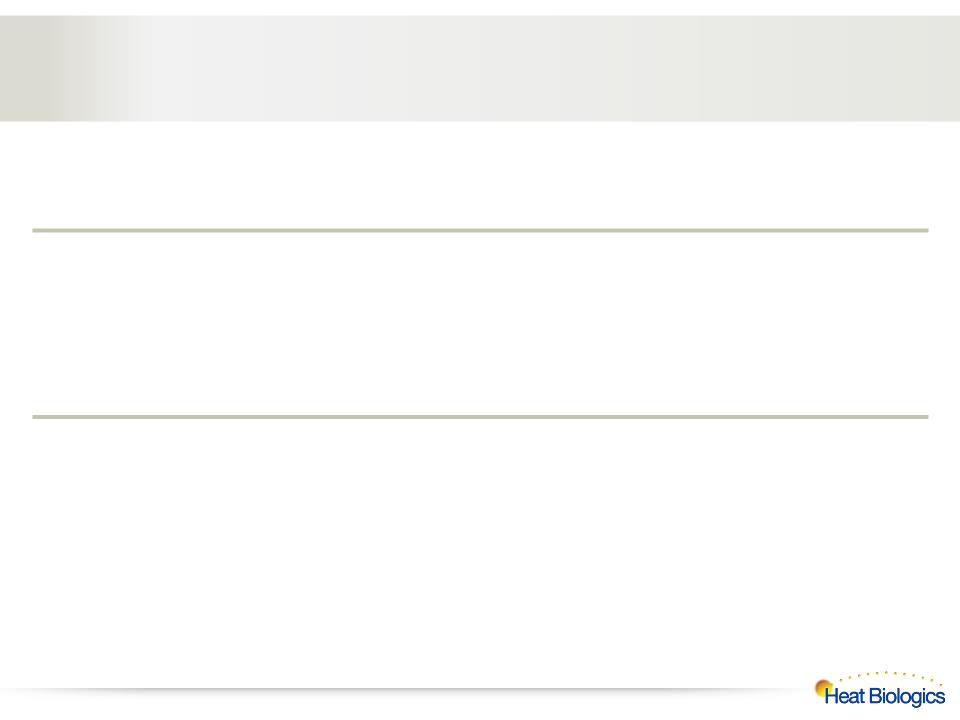
14
IP Estate with Broad and Early Filings
Strong Intellectual Property Protection
ImPACT Platform Technology
l US and foreign patents issued for ImPACT technology for the treatment of cancer and
viral disease
viral disease
l Additional patents on proprietary cell lines and clinical data
Worldwide Filings
l 5 patent families representing over 50 patent applications
l Enforceable patents issued in 15 countries and counting

15
Lung Cancer and HS-110
Background
Heat’s HS-110 Therapy
• Cells are genetically modified to secrete gp96
and most known (and many unknown) lung
cancer antigens
and most known (and many unknown) lung
cancer antigens
• Pan-antigen cytotoxic T-cell immune response
Treatment
• Powerful immune activation
• Positive safety profile based on preclinical
studies and one clinical study
studies and one clinical study
• The drug is administered in a simple,
once-a-week injection
once-a-week injection
Survival Curve for Late-Stage 3B/4
NSCLC Patients*
NSCLC Patients*
* Massarelli E. Lung Cancer;2003:39 - Meta Analysis
Current Treatment
• Surgical Resection
• Radiation Therapy
• Chemotherapy
–3-6 cycles
–Each cycle lasts 3-4 weeks
• Targeted Therapies
Survival Prospects
• Median survival ~ 4.5 months*
• 1 year survival >6%*
“Without any chemotherapy, the average person will live about 4½ months.
With chemotherapy most will live longer and some will live a shorter time. More recent chemotherapy trials
have shown that people live about 3 months longer than if they did not get chemotherapy …
With chemotherapy most will live longer and some will live a shorter time. More recent chemotherapy trials
have shown that people live about 3 months longer than if they did not get chemotherapy …
… Even with chemotherapy, the chance of being alive at one year is about 30-50%;
the chance of dying within this year is 50-70%.”
the chance of dying within this year is 50-70%.”
— American Society for Clinical Oncology (ASCO) Guidelines
Lung Cancer is the Second Most Common Cancer in
US with No Reliable Treatment Options for Late-Stage
Patients
US with No Reliable Treatment Options for Late-Stage
Patients

16
HS-110: Phase 1 Lung Cancer Trial Design
l NIH-funded, open-label, single center investigator-sponsored IND
l 18 patients with late-stage NSCLC
l Participants had previously failed multiple lines of therapy
Stage IIIB/IV NSCLC
Median 7 Prior Therapies & Progressive
Disease at Enrollment
Disease at Enrollment
Alternating After First 8 Patients
Cohort 3
¼ Strength Dose Twice Weekly
¼ Strength Dose Twice Weekly
(10,000,000 Cells)
Cohort 2
½ Strength Dose Weekly
½ Strength Dose Weekly
(20,000,000 Cells)
Cohort 1
1 Dose Every 2 Weeks
1 Dose Every 2 Weeks
(40,000,000 Cells)
Safety
Immune Response,
Tumor Response,
Immune Response,
Tumor Response,
Overall Survival,
Progression Free Survival
Progression Free Survival

17
HS-110 NSCLC Phase 1 Clinical Trial Results
l Well-tolerated with no overt toxicity and no treatment-related SAEs
l 18 patients treated, 15 patients completed first course of therapy, 2 patients
completed 3 courses of therapy
completed 3 courses of therapy
l Single agent clinical activity in late-stage 3b and 4 lung cancer
• As is typical in immunotherapy, no observed partial or complete responses
• 7 patients exhibited stable disease after single course of therapy
l Immune response observed in 73% (11 out of 15) of patients who
completed their first course of therapy
completed their first course of therapy
– Immune response predictive of survival (HR: 0.021, 95% CI:0.002-
0.204)
0.204)
• The 11 immune responders exhibited a median survival of 16.9 months (95%
CI: 7.1-20) while the 4 immune non-responders exhibited a median survival of
4.5 months, which is consistent with the expected survival times in this patient
population
CI: 7.1-20) while the 4 immune non-responders exhibited a median survival of
4.5 months, which is consistent with the expected survival times in this patient
population
– Two late-stage patients survive >3 years
• One HS-110 patient alive >3 yrs. and another patient still alive >4 yrs.
l Median 1 year overall survival rate of patients in the study was 44% (95%
CI: 21.6-65.1) comparing favorably to a 5.5% rate based on published data
from a 43-patient advanced NSCLC population
CI: 21.6-65.1) comparing favorably to a 5.5% rate based on published data
from a 43-patient advanced NSCLC population
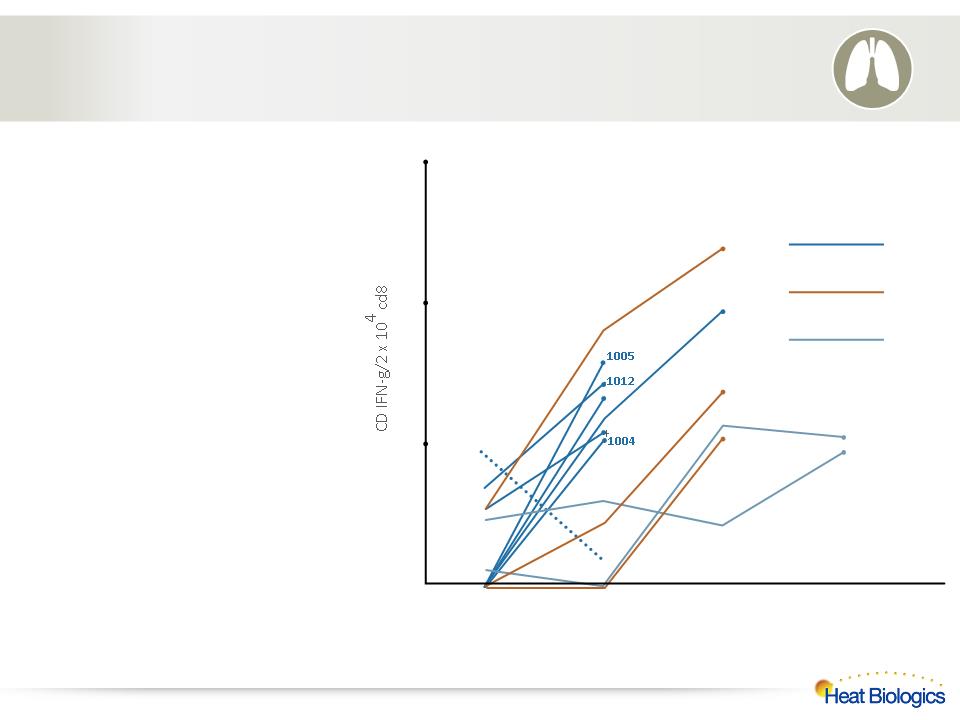
18
Highly Activated Immune Response
Methodology
• Samples collected for immune
response at baseline and after a
minimum of one 6-week course of
therapy were analyzed
response at baseline and after a
minimum of one 6-week course of
therapy were analyzed
• To determine the frequency of CD8
IFN-γ, purified CD8 T cells collected
from patients were stimulated with
vaccine
IFN-γ, purified CD8 T cells collected
from patients were stimulated with
vaccine
• + indicates first increase, solid lines
indicate immune response (IR+),
dashed lines no response (IR−)
indicate immune response (IR+),
dashed lines no response (IR−)
Baseline
1000
Post 1
Post 2
Post 3
100
10
1
Cohort 2 (n=3)
Cohort 3 (n=3)
Cohort 1 (n=9)
1019
1013
1014
1002
1009
1008
1003
1016
1011
1017
1018
+
+
+
+
+
+
+
+
+
+
+
Results
• In 11 of the 15 patients (73%)
completing the first course of therapy
with HS-110, there was a twofold or
greater increase in CD8 cells secreting
interferon gamma (CD8-CTL IFN-γ)
following vaccination
completing the first course of therapy
with HS-110, there was a twofold or
greater increase in CD8 cells secreting
interferon gamma (CD8-CTL IFN-γ)
following vaccination
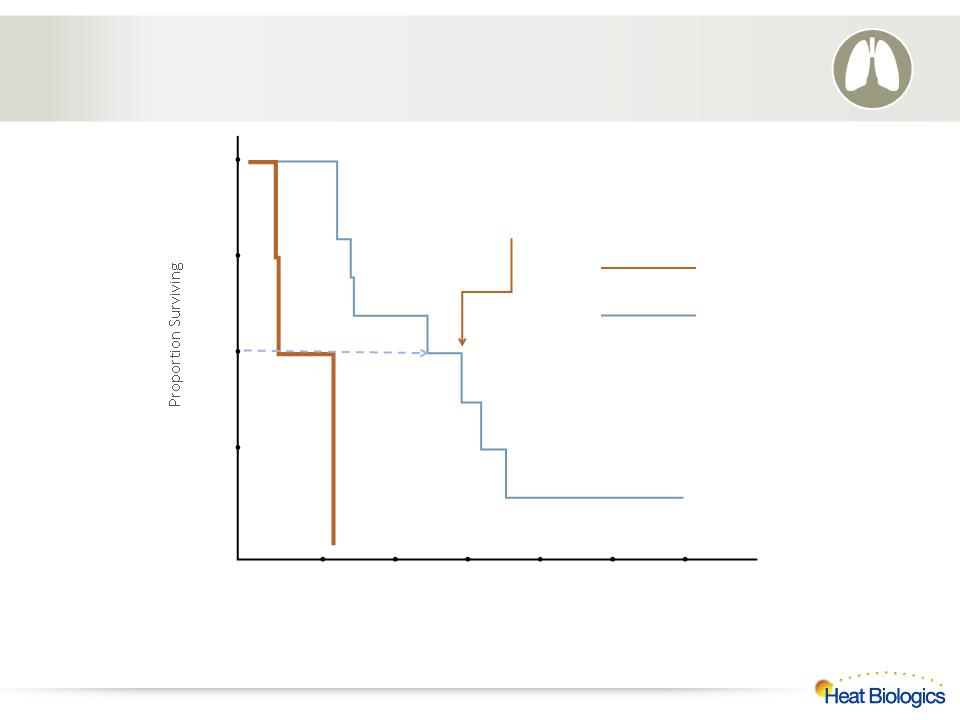
19
Immune Response Predictive of Survival
In 11 of the 15 patients (73%) completing the first course of therapy with HS-110, there was a twofold or greater increase in CD8 cells
secreting interferon gamma (CD8-CTL IFN-γ) following vaccination. In a non-prespecified analysis, the responders saw a threefold
increase in median overall survival compared to non-responders in the trial, from 4.5 months to 16.9 months
secreting interferon gamma (CD8-CTL IFN-γ) following vaccination. In a non-prespecified analysis, the responders saw a threefold
increase in median overall survival compared to non-responders in the trial, from 4.5 months to 16.9 months
Non-Responders
Responders
>3x Extension of Median OS
for Responders
for Responders
6
12
18
24
30
36
0.25
0.50
1.00
0.75
Months From Treatment Start
0
(N=4)
(N=11)
Hazard Ratio: 0.021
95% CI: 0.002 - 0.204
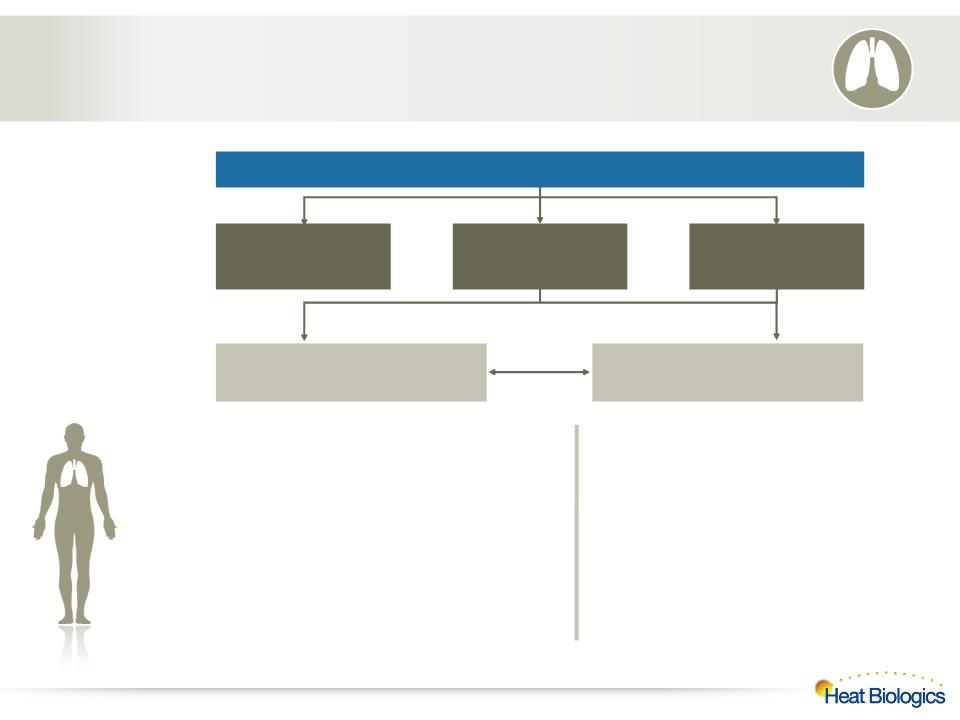
20
Phase 2 NSCLC Trial Design
Inclusion Criteria
l Stage III/IV NSCLC patients
l Prior treatment with platinum doublet,
crizotinib, erlotinib as 1st line treatment
crizotinib, erlotinib as 1st line treatment
l Achieved clinical response (CR/PR) or disease
stabilization following 1st line treatment
stabilization following 1st line treatment
Stage 2
N = 90
Proof of Concept
Stage 1
N = 30
Dose Finding
Placebo
N = 30
HS-110
Optimal dose N = 60
Optimal dose N = 60
Phase 2 - 2 Stage Adaptive Design
Proceed with Optimal Dose
Placebo
N = 6
HS-110
Low Dose N = 12
2,000,000 cells
HS-110
High Dose N= 12
10,000,000 cells
Trial Objectives
l Stage 1: Dose finding and safety
l Stage 2: Progression-free survival
In addition, a grant-funded, investigator-sponsored Phase 1 NSCLC trial will explore use of HS-110 as combination therapy
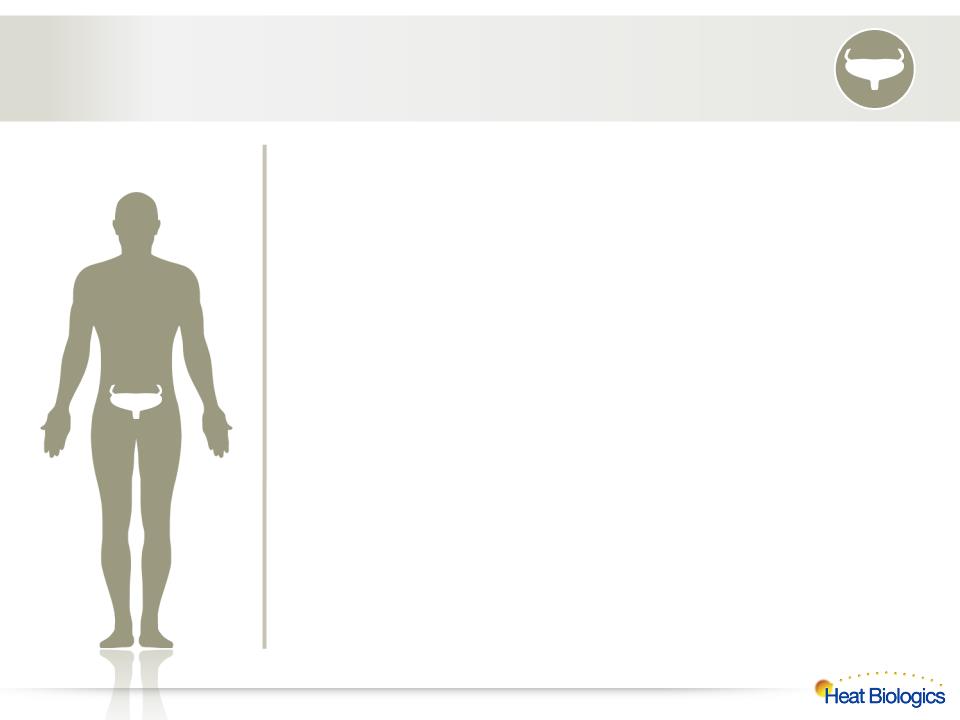
21
Bladder Cancer and HS-410
Background
l Currently-available treatments have high failure rate and are
poorly tolerated
poorly tolerated
l Among highest lifetime treatment cost per patient of any
cancer due to a high recurrence rate
cancer due to a high recurrence rate
l Opportunity to treat patients with minimal residual disease
l Drug manufacturing and preparation of IND and protocol
for HS-410 in progress
for HS-410 in progress
l No new drugs for this patient population in >25 years
l HS-410 Phase 1/2 trial scheduled to begin in Q3 of 2013 and
will include ~100 patients
will include ~100 patients
In 2012 Alone, There Were 73,000 New Cases
of Bladder Cancer Reported and 15,000 Deaths
of Bladder Cancer Reported and 15,000 Deaths
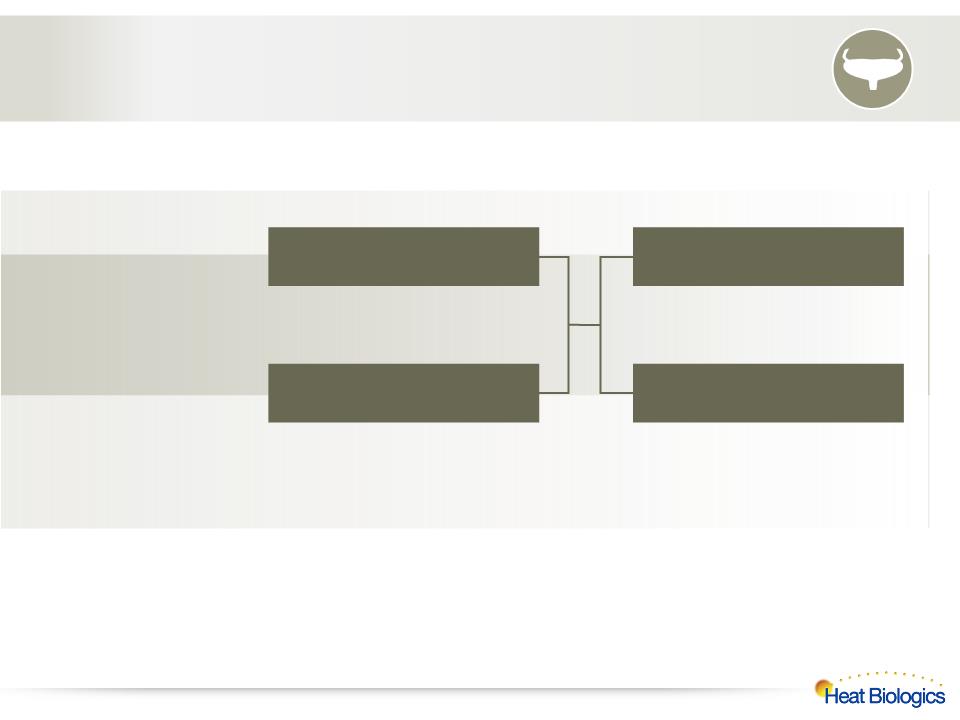
22
HS-410: Phase 1/2 Clinical Trial Design
Bladder Cancer
l HS-410 administered within existing standard of care guidelines
l Majority of cases are superficial (non-muscle invasive), treated with surgery
followed by 6 weeks of interstitial BCG therapy
followed by 6 weeks of interstitial BCG therapy
Stage 1/2a
Cancer Surgical Resection
Followed by BCG
Followed by BCG
N = 93
HS-410
N = 50
N = 50
Placebo
N = 25
N = 25
HS-410 LD
N = 9
N = 9
HS-410 HD
N = 9
N = 9
1:1 Randomization
12 Weekly Injections;
Then Monthly X 3
Then Monthly X 3
Trial Objectives
Trial Objectives
Dose Ranging
Optimal Dose
l Safety and tolerability
l Optimal dose based on
immune response
immune response
l Time to recurrence
l Immune response
l Safety and tolerability

23
Diverse Product Pipeline
*Investigator-sponsored, grant-funded study
Planned
Planned
Planned*
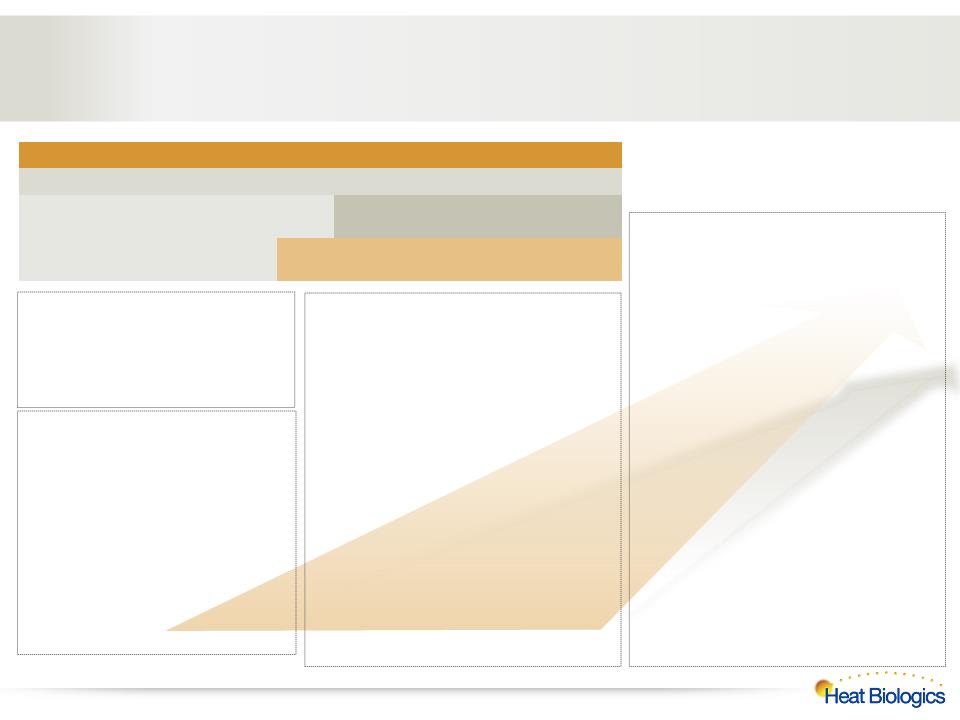
24
IPO Milestones and Upcoming Events
2013 Milestones
qHS-110 lung cancer
qInitiate 120 patient Phase 2 clinical trial
qPhase 2 patient enrollment
qHS-410 Bladder Cancer
qPre-IND FDA meeting
qHS-410 scale manufacturing
qInitiate 93 patient Phase 1/2 clinical trial
qComplete stage 1 enrollment
qImmune response data readout
q Corporate and other
qEnhance management team
qContinued grant filings and notifications
qOvarian cancer cell line development
2014 Milestones
qHS-110 lung cancer
qStage 1 enrollment completes
qImmune response data readout
qPFS data readout
qHS-410 Bladder Cancer
qTrial enrollment completes
qImmune response data readout
qTime-to-recurrence data readout
q HS-310 Ovarian Cancer
qFile IND
qFirst patient enrolled
qEnrollment completes
qImmune response data readout
q Corporate and other
qContinued grant filings and notifications
qVarious clinical publications
2012 Milestones
qHS-110 lung cancer
qPhase 1 trial completion and
publication *
publication *
qPhase 2 protocol design
qHS-110 GMP manufacturing
qHS-410 Bladder Cancer
qCell line development
qPhase 1/2 protocol design
ü
ü
ü
ü
ü
ü
ü
ü
ü
ü
ü
ü
|
|
2013
|
2014
|
||||||
|
|
Q1
|
Q2
|
Q3
|
Q4
|
Q1
|
Q2
|
Q3
|
Q4
|
|
HS-110
Lung Cancer
|
|
Phase 2 Clinical Trial
~120 Patients
|
||||||
|
HS-410
Bladder Cancer
|
|
|
Phase 1/2 Clinical Trial
~100 Patients
|
|||||
IPO funds will be used to
progress two drug
candidates to Phase 3
clinical trials
progress two drug
candidates to Phase 3
clinical trials
*Investigator-sponsored, grant-funded study
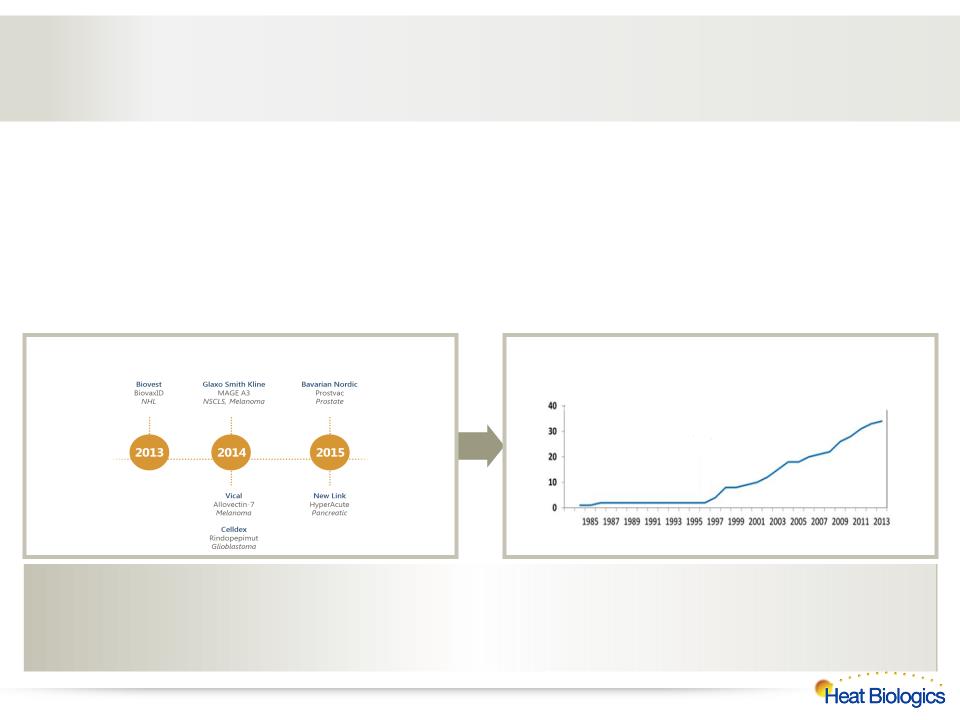
25
Immunotherapy Gaining Momentum
Immunotherapy on the cusp of great industry breakthroughs with several BLA
approvals anticipated in coming years
approvals anticipated in coming years
l“Technology ripening” period for immunotherapies may be similar to antibodies
Highly-novel approach to activate cytotoxic
T-cells against multiple tumor antigens simultaneously
T-cells against multiple tumor antigens simultaneously
lPotential to be complimentary with “checkpoint inhibitors” currently in the clinic
Approvals
Cumulative FDA Antibody Approvals
Select Immunotherapy NDAs Expected
“In a decade immunotherapy cancer drugs will be treating 60% of cancers and
generating annual sales of up to $35 billion.”
generating annual sales of up to $35 billion.”
— Andrew Baum, MD
Head of Global Healthcare Research, Citi
Head of Global Healthcare Research, Citi
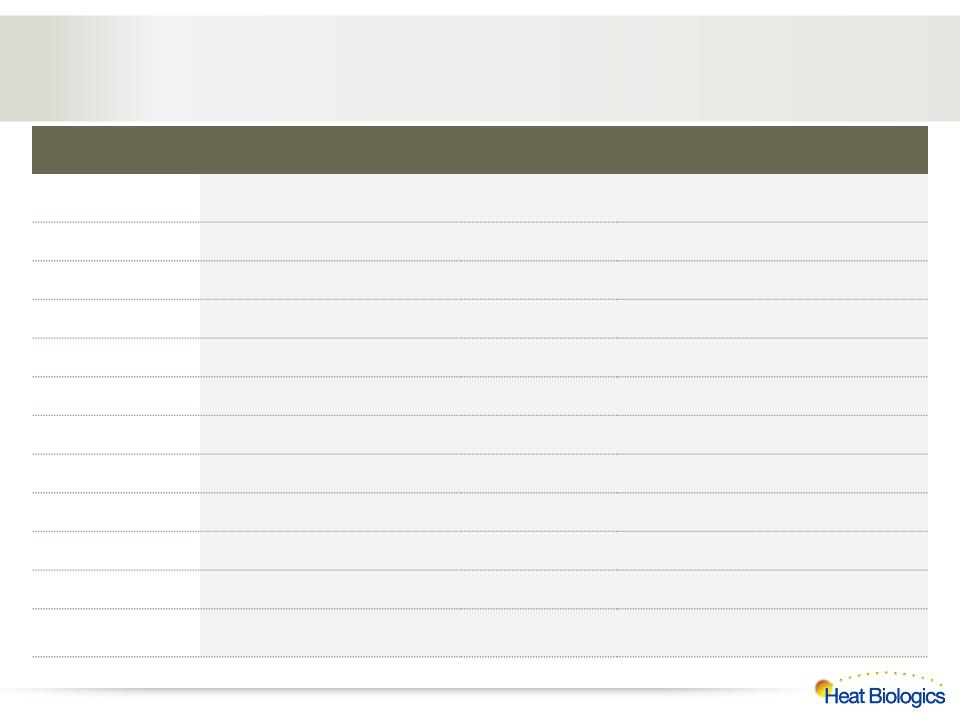
26
Select Immunotherapy and Oncology-Focused
Comparables
Comparables
|
COMPANY
|
FOCUS
|
LEAD CATEGORY
|
STAGE OF
DEVT. |
VALUATION*
|
|
Heat Biologics
|
Live T-cell vaccine platform
|
NSCLC
|
Phase 2 (Post
IPO) |
~$70M
|
|
Newlink Genetics
|
Live-cell vaccines
|
Pancreatic
|
Phase 3
|
$556M
|
|
Stemline
|
Cancer stem cells
|
Leukemia
|
Phase 1/2
|
$304M
|
|
Verastem
|
Cancer stem cells
|
Ovarian
|
Phase 1/2
|
$270M
|
|
Infinity Pharma
|
Small molecules
|
NSCLC
|
Phase 2
|
$901M
|
|
Array Biopharma
|
Small molecules
|
Multiple Myeloma
|
Phase 2
|
$571M
|
|
Celldex
|
APC targeted immunotherapies
|
Glioblastoma
|
Phase 3
|
$1.2B
|
|
Clovis Oncology
|
EGFR inhibitor
|
NSCLC
|
Phase 1
|
$1.6B
|
|
Puma Biotech.
|
Tyrosine kinase inhibitor
|
Breast
|
Phase 2
|
$1.2B
|
|
Immunocellular
|
Autologous dendritic cell vaccine
|
Glioblastoma
|
Phase 2
|
$114M
|
|
Okairos
|
T-cell vaccine platform
|
----
|
Preclinical
|
$323M GSK Buyout
|
|
Biovax
|
Modified virus injected into tumor
|
Melanoma
|
Phase 3
|
Up to $1B ($425M
upfront) Amgen Buyout |
* Valuation as 6-24-13

27
Capitalization Structure
|
CAPITALIZATION (as of 5/21/13)
|
SHARES OUTSTANDING
|
% OUTSTANDING
|
|
|
|
|
|
Common Stock*
|
3,583,654
|
84%
|
|
Stock Options
|
662,543
|
15%
|
|
Warrants
|
53,159
|
1%
|
|
Fully Diluted Shares Outstanding
|
4,299,356
|
100%
|
|
|
||
|
|
||
*Assuming all preferred stock converts to common stock as of May 21, 2013
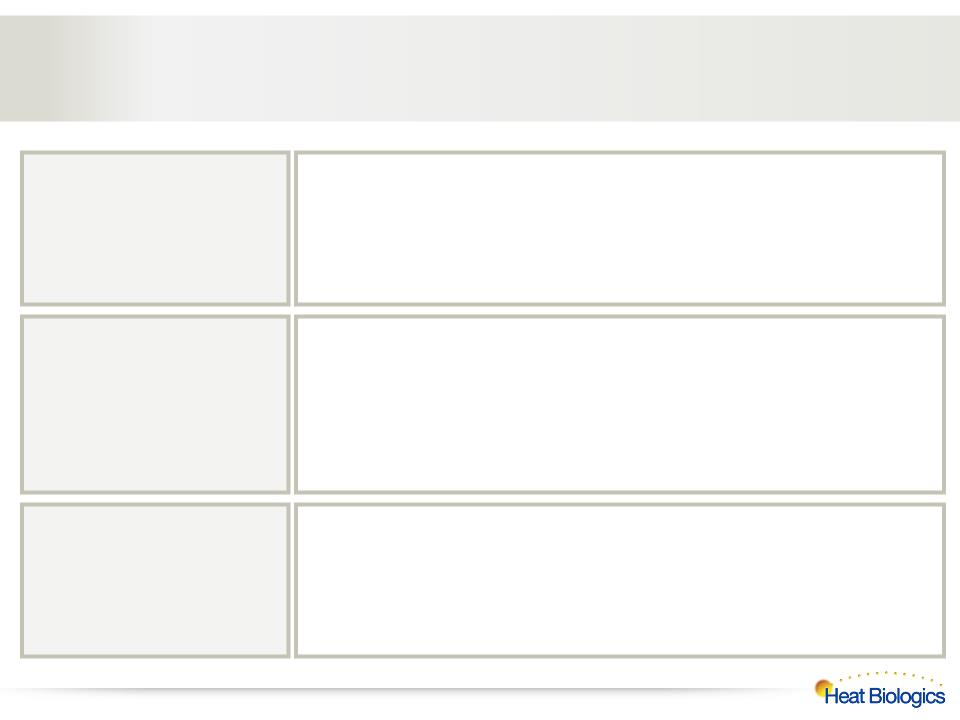
28
Summary
Clinical Stage Platform Technology Generating Promising Human Data
Clinical Stage Platform Technology Generating Promising Human Data
Data to Date Demonstrate:
•Positive safety profile
•Powerful, disease-specific immune activation
•Immune activation corresponds with increased overall survival in
initial 15 patients
initial 15 patients
Encouraging
Clinical Data
Strong Clinical Pipeline
•Phase 2 NSCLC clinical trial and Phase 1/2 bladder cancer trial
following IPO with additional IND submissions planned
following IPO with additional IND submissions planned
•Near-term enrollment and data readouts
Value Creating
Milestones
Milestones
Transformational
Technology Platform
Technology Platform
Unleashes the immune system against a wide range of
cancers
cancers
•Over a decade of published research and recent clinical data
